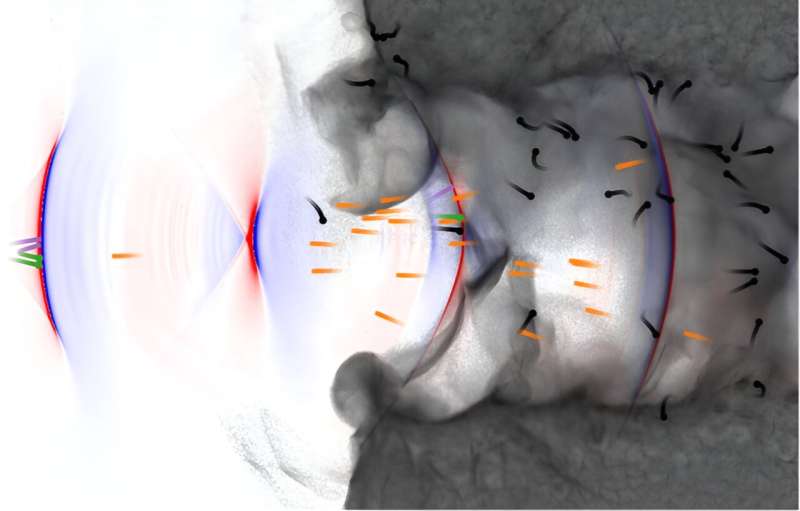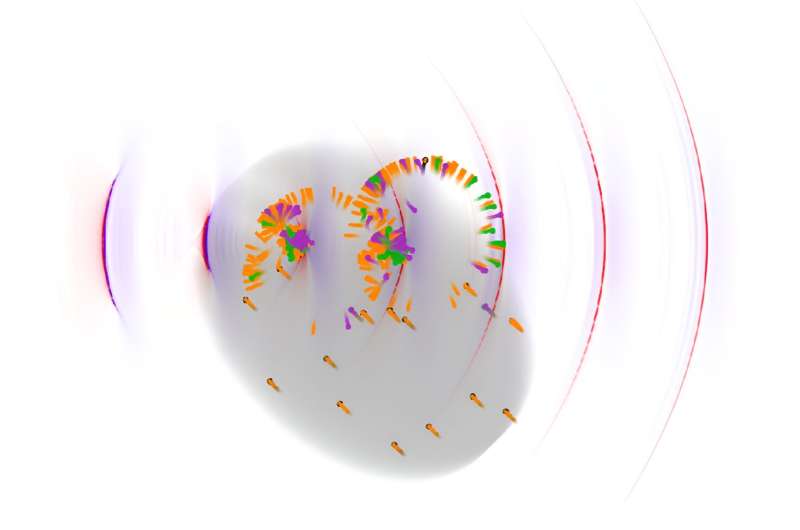June 10, 2024 feature
This article has been reviewed according to Science X's editorial process and policies. Editors have highlighted the following attributes while ensuring the content's credibility:
fact-checked
peer-reviewed publication
trusted source
proofread
How does light interact with matter at extreme intensities, near the Schwinger limit?

The experimental generation of increasingly intense light beams could help to unveil new physical regimes occurring in the presence of very strong electromagnetic fields. While some progress has been made towards this goal, physicists are yet to develop a reliable strategy to achieve extreme light intensities.
Researchers at LIDYL, CEA, CNRS, Université Paris-Saclay recently proposed a realistic method to reach unprecedented light intensities in experimental settings, using tightly focused doppler-boosted lasers. This method, outlined in a paper published in Physical Review Letters, was theoretically found to enable light-matter interactions near the Schwinger limit.
"The paper exploits an idea that emerged in our team at France's Alternative Energies and Atomic Energy Commission (CEA-LIDYL) in 2019 and that has been extensively studied since then in collaboration with the Lawrence Berkeley National Laboratory (especially regarding the modeling aspects)," Henri Vincenti and Neil Zaim, co-authors of the paper, told Phys.org.
"Within this collaboration, we are devising a new technique to produce a light source at an unprecedented intensity and researching how such a light source could be used to explore the strong field regime of quantum electrodynamics (SF-QED)."
QED, the relativistic quantum theory of electrodynamics, is among one of the most accurately tested physics theories. Its strong-field regime, however, remains largely unexplored, due to current difficulties in probing it experimentally.
"The theory of SF-QED has been developed decades ago and predicts the emergence of new physical regimes in the presence of very strong electromagnetic fields, where gamma-ray emission and antimatter (electron-positron pairs) production are prevalent and where even light propagation in vacuum becomes nonlinear," Vincenti and Zaim said.
"For instance, an intense light beam can modify the propagation of another light beam crossing its path, a regime not described by Maxwell's equations that are linear by essence."
Strong field regimes are theorized to occur in the vicinity of massive astrophysical objects, including black holes and neutron stars, as well as during extreme astrophysical events, such as gamma-ray bursts. These cosmological phenomena are not yet fully understood, thus studying the extreme regimes associated with them in laboratory settings could prove highly insightful.
Until now, however, scientists have been unable to successfully reproduce SF-QED dominated regimes in experimental settings. The few experiments that attempted to do so relied on large-scale particle accelerators, yet they could only detect a small number of SF-QED processes.
"These regimes are challenging to reproduce in a laboratory setting because SF-QED phenomena occur when electromagnetic fields approach the so-called Schwinger limit (~1018 V/m or equivalently ~1029 W/cm2); orders of magnitude above state-of-the-art laser technology, which can 'only' produce intensities up to ~1023 W/cm2," Vincenti and Zaim said.
"In fact, it is often considered impossible to reach the Schwinger field in the laboratory frame. Thus, all past and proposed experiments rely on reaching the Schwinger limit only in the rest frame of very energetic particles."
Vincenti, Zaim and their colleagues hope that their proposed technique to generate highly intense light will open new opportunities for research. Specifically, it could eventually allow physicists to approach the so-called Schwinger limit in a laboratory setting.
"In our 2019 paper, we validated with state-of-the-art numerical simulations the feasibility of our light boosting technique," Vincenti and Zaim said.
"Our simulations indicated that this method could increase the intensity of a PW laser by 2 to 5 orders of magnitude, potentially making the 1025-1028 W/cm2 intensity range within the reach of current laser technology. In a 2021 paper published in Nature Physics, we obtained a first experimental confirmation of this result with a more moderate intensity (~1019 W/cm2) terawatt (TW)-class laser."
In a further paper published in 2021, Vincenti and his collaborators outlined the results of further numerical simulations. These results demonstrated that even at the lowest intensities that they hope to achieve using their proposed method (~1025 W/cm2), the boosted light would be sufficient to trigger much more SF-QED phenomena than those probed by a conventional PW laser.
"This could lead to a new kind of SF-QED experiments in the coming years," Vincenti and Zaim said. "In this case, however, we are still orders of magnitude from reaching the Schwinger limit in the laboratory frame, as it is only exceeded in the rest frame of energetic particles."
While the researchers had already run various numerical simulations to theoretically validate their approach, one of its potential applications was yet to be explored. Specifically, the team had not yet explored its potential for approaching the Schwinger limit in a laboratory frame.

"This corresponds to the highest intensities that we hope to achieve with our light boosting technique (~1028 W/cm2)," Vincenti and Zaim. "The objective of this new paper was to explore the physical scenarios that come into play in these uncharted territories, using state-of-the-art numerical tools. Such results are very important to motivate, define and prepare the future generations of SF-QED experiments."
To produce light of an unprecedented intensity, the technique proposed by Vincenti and his colleagues leverages the interaction between a PW laser and a flat solid target, which is ionized into a plasma. Specifically, the researchers proposed hitting an optically polished solid target with a laser beam of ultrahigh intensity, leading to the formation of a so-called plasma mirror.
This plasma mirror reflects the incident light and is also moved by the intense laser field. This motion results in the temporary compression of the reflected laser pulse, which is then converted to a shorter wavelength by the Doppler effect. The radiation pressure from the laser gives the plasma mirror a natural curvature, focusing the Doppler-boosted beam onto smaller spots and theoretically producing intensity gains of over three orders of magnitude in these spots.
"The key additional ingredient needed to reach the highest intensities approaching the Schwinger limit (say ~1028 W/cm2, rather than ~1025 W/cm2), is the ability to focus the boosted light down to its smallest possible volume," Vincenti and Zaim explained.
"We are currently exploring several paths to achieve such a tight focusing in experiments, for instance, by using external refocusing extreme ultraviolet optics. Some of these techniques already look very promising and will be the subject of future publications."
In their recent paper, Vincenti and Zaim made no assumption about the method used to tightly focus the Doppler-boosted light, as this would allow them to represent various potential options in their numerical simulations. Instead, they merely assumed that they could focus the light to its smallest possible volume (i.e. its diffraction limit).
"The results that we have obtained are very exciting, as they show that approaching the Schwinger limit in the laboratory frame leads to new and extremely rich light-matter interactions scenarios, lying at the frontier of modern physics," Vincenti and Zaim said.
"The simple interaction between our boosted light and a solid target leads to a profusion of SF-QED events that dominates the physics. Typically, between 30% and 50% of the boosted light energy is converted into gamma-rays and electron-positron pairs in a few tens of femtoseconds by SF-QED processes."
The numerical simulations run by the researchers also showed that their method leads to generated gamma photons and electron-positron pairs being bunched into dense fireballs that move at the speed of light. While these fire balls have a short life of approximately 1 fs, the team think that they could mimic the electron/positron jets that exist in the proximity of black holes and neutron stars, thus they help to unveil the origin of the radiation they emit.
"At the highest intensities that we could reasonably consider (>1028 W/cm2), we discovered that the physics becomes even more radical: chain reactions of particle creation start occurring," Vincenti and Zaim said.
"In other words, photons and electron-positron pairs create themselves new photons and pairs, exponentially increasing the density of the fireballs up to more than 5,000-times the density of a solid. It is not too unreasonable to think that such a chain reaction mechanism has the potential to give rise to new advanced sources of gamma-rays bursts and antimatter."
Vincenti, Zaim and his colleagues theoretically showed that the collision of their Doppler-boosted light with an energetic electron beam originating from a particle accelerator could also lead to interesting results. In this configuration, in fact, the field in rest frame of the electrons becomes so high that the perturbative theory developed for SF-QED breaks down.
"In other words, we have as of today, no clue what would happen in such an experiment," Vincenti and Zaim explained.
"This lack of theoretical framework is likely both due to the mathematical complexity of nonperturbative quantum field theory and to the fact that researchers thought for many years that it would be impossible to reach such high electric fields in the rest frame of an electron. Our guess is that these kinds of results will further revive the interest in the nonperturbative regime of SF-QED and spur the development of new theoretical or numerical frameworks better suited to this regime."
The results gathered by the researchers so far suggest that performing experiments close to the Schwinger limit would yield exciting new results that could greatly contribute to the fields of plasma physics and QED. In their next studies, they plan to start applying their proposed method in real experiments, in collaboration with major laser facilities worldwide.
"The main challenge that we anticipate is to actually produce the highest possible light intensities (up to 1028 W/cm2) in a real-world environment with experimental imperfections (both laser and targetry) and limited beam time," Vincenti and Zaim said. "Identifying and mitigating the hurdles that lie ahead will require the combination of theoretical, numerical and experimental expertise."
The researchers forecast that in the first experiments, they will be able to create boosted light with intensities around 1025 W/cm2. While these intensities would still be far from the Schwinger limit, they would still be a world record, paving the way for high-impact SF-QED experiments that have never been performed before.
"We would then take advantage of the feedback from previous experiments and of future progress in laser technology to increase gradually the boosted light intensity from here up to the Schwinger limit," Vincenti and Zaim added. "This will allow us to obtain more and more spectacular SF-QED dominated interactions. We are therefore convinced that there are exciting times ahead."
More information: Neïl Zaïm et al, Light-Matter Interaction near the Schwinger Limit Using Tightly Focused Doppler-Boosted Lasers, Physical Review Letters (2024). DOI: 10.1103/PhysRevLett.132.175002. On arXiv: DOI: 10.48550/arxiv.2303.17581
Journal information: Nature Physics , Physical Review Letters , arXiv
© 2024 Science X Network




















